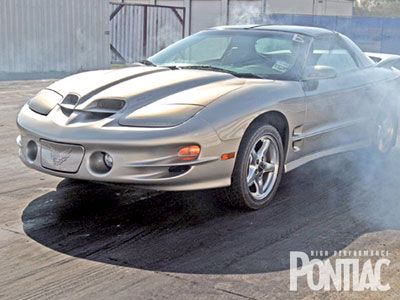
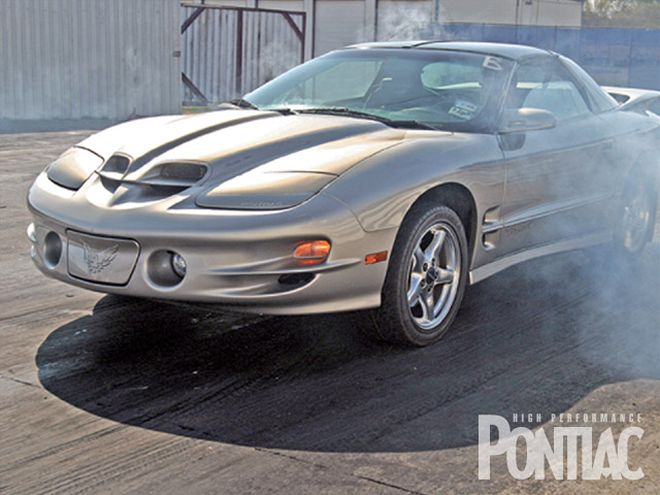
In "LS1 Power Plan" (HPP Aug.-Oct. '08), our subject '00 WS6 T/A registered 381.1 rwhp and 365.8 lb-ft of torque, having gained an impressive 62.1 hp and 36.5 lb-ft. That "cam-only" configuration was both powerful and well mannered on the streets, and it put down a 12.79 e.t. at 109.59 mph to back up the dyno numbers.
To further separate the car from the crowd and generate more than 400 rwhp, the next stage was a "heads/cam car." Research for a set of higher flowing LS1/LS6-style cylinder heads that would fit with the stock LS1 bore led to myriad choices, both in factory- and aftermarket-based products. Adding real-life family budgeting, however, eliminated much of the aftermarket cylinder-head offerings. Luckily for the enthusiast, there are budget-friendly alternatives in ported factory heads, which led us to Texas Speed & Performance and Precision Race Components (PRC), that suggested using its PRC 220cc 5.3L Stage 2.5 heads.
According to co-owner Jason Mangum, "Those looking for a considerable gain in power for street/strip, small-bore LS series engines such as this, the 5.3L head offers it at a budget price. Along with raising the stock compression up to 11.00:1 to generate additional power, the head also performs almost identically to the costlier LS6 and LS2 castings. The key to making power with the 5.3 head is to revise the combustion chamber size and to replace the small stock valves (1.89/1.55-in) with oversize stainless steel ones. Although various sizes are available, the Stage 2.5 offerings come with 2.02-inch intake and 1.575-inch exhaust stainless valves."
Since the testing and development of the CNC program focused on maintaining a strong port velocity and a balanced intake and exhaust flow, the heads are well matched to the existing Comp cam (XER273HR, 224/230-degrees duration at 0.050 and 0.581/0.588 lift on a 114-degree lobe separation angle) and the supporting SLP LS6 manifold and Jet-Hot exhaust system with Corsa after-cat.
In addition to the heads, Jason strongly recommends that the small 26.4-lb/hr factory injectors be upgraded to a larger set of F.A.S.T 42-lb/hr injectors to ensure they can supply the engine with adequate fueling. As well as the increased flow rate, the F.A.S.T. injectors feature a wide 30-degree spray angle for superior fuel atomization and state-of-the-art technology to improve injector opening times and ensure crisp throttle response. Jason says, "The F.A.S.T. high-impedance injectors are high-quality and, unlike some other brands on the market, very easy to tune to achieve excellent idle-quality and low-rpm response."
After picking up a set of bare PRC Stage 2.5 heads (PN 199-PRC2.55.3) for $1,000, we swapped over the Comp Cams 921 double springs and titanium retainers from "LS1 Power Plan" and took you through the installation of the PRC Stage 2.5 heads in Part I.
Follow along as Matt Garzonie at Real Performance Motorsports in Lewisville, Texas, wraps up the installation of the PRC head package and replaces the factory fuel injectors with the F.A.S.T. ones. Once complete, Harold Baker's automatic-equipped '00 WS6 T/A will be retuned by Brian Lohse and unleashed on RPM's Dynojet chassis dyno. After documenting the results from the dyno session, the T/A will be strip tested at San Antonio Raceway in Marion, Texas.
Dyno Tuning, Testing & Results
Dyno testing of the WS6 '00 Trans Am was performed at Real Performance Motorsports in Lewisville, Texas. Its Dynojet Model 248C dyno is optioned with the above ground kit and Commander wide-band 02 sensor so that air/fuel ratios can be charted.
Right out of the box, the PRC heads showed some real promise by registering 407.7 hp on the first dyno pull. As documented in "LS1 Power Plan," the experience and knowledge of the tuner comes into play in maximizing the combination. Although the air/fuel was on average a bit richer at 12.4:1, Brian Lohse knew there was more power lurking in the lines of code.
According to Lohse, "In general, anytime an enthusiast goes to a ported cylinder head, the combination of quality, aftermarket stainless steel valves and revisions to the combustion chamber almost always allow the tuner to increase timing and adjust the air/fuel ratio to account for variances in port flow and velocity.
"The timing was adjusted from a baseline of 24 degrees up to 26 degrees, one degree at a time. Air/fuel ratio was almost identical to the baseline except in the rpm range of 4,700-6,200. Prior to the PRC heads, the T/A would only pull to 6,200, but the extra intake and exhaust flow allowed it to generate power up to 6,400 rpm.
"To account for the increased flow, the fuel was trimmed on dyno runs two and three by 2 percent each time over the range of 4,700-6,700 rpm. On the final run, the fuel was trimmed an additional 2 percent from 5,800-6,700 rpm, and the timing remained at 26 degrees as it had in run three.
"Although there were no signs of detonation in the dyno pull, the tune was left alone to ensure that the engine would run very consistent times when bracket racing under similar heat-soaked conditions. Additional power likely can be generated by adding more timing or leaning the air/fuel mixture out, but the upside of a few more horsepower was outweighed by the risk that the compu-ter would register knock and pull timing, leading to reduced power and an early exit from competition. Achieving 417 rwhp and 385.7 lb-ft of torque through an automatic transmission with a street-friendly cam that can easily run around town or throw down low to mid-12-second timeslips speaks well for the overall combination."
Peak and average horsepower and torque are from dyno pulls recorded between 3,900 and 6,200 rpm for the baseline and 3,900 and 6,400 for the Texas Speed heads configuration.
Dyno Graph
Baseline:
Test parameters: Inlet air temperature, 77.1 degrees Fahrenheit; barometric pressure, 29.72 hg; vapor pressure 0.15 in. hg; correction factor 0.99
Texas Speed Heads:
Test parameters: Inlet air temperature, 112.2 degrees Fahrenheit; barometric pressure, 29.14 hg; vapor pressure, 0.6 in. hg; correction factor, 1.07
Conclusion
After installing the heads and having Brian Lohse work his magic on the tune, the T/A belted out 417 rwhp and 385.7 lb-ft of torque. Gains attributable to swapping to the PRC heads were robust at 35.9 and 19.9 respectively. Almost as impressive were the average gains in horsepower and torque, along with the fat power curve. In addition to cresting the baseline at every rpm spot, the cylinder heads really started to shine once the cam got into the mid-range and beyond. From 4,900 rpm up to redline, the horsepower and torque averaged gains of 27 and 28 respectively. Although the overall average gains were more conservative at 25.4 hp and 18.5 lb-ft of torque, all of this was done without compromising idle quality or low-rpm drivability.
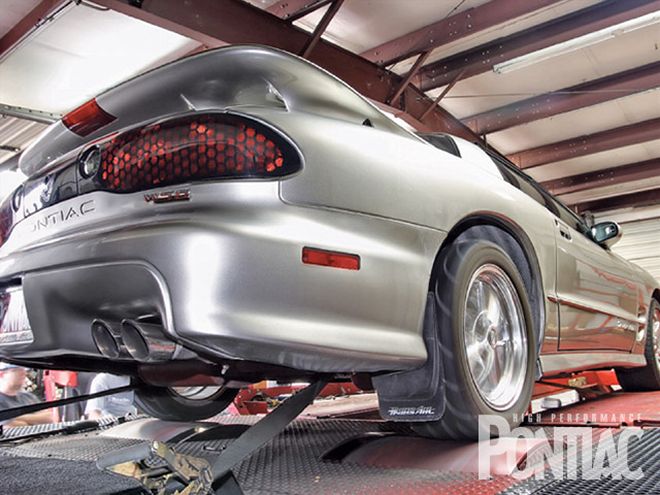
Harold Baker says, "The gains on the dyno when one factors in a 20-percent driveline loss indicate that the engine is putting out 500 crankshaft horsepower. For a small-bore 346 to generate those lofty numbers is quite an accomplishment. On the street, the T/A continues to be well mannered; the combination of the PRC heads, F.A.S.T injectors, and updated tune make the engine even more responsive off-idle and in the mid-range. Once the engine rpm starts to rise, the power just keeps building until the tach sweeps to redline."
By changing to the PRC cylinder heads that offer a budget price and significantly enhanced breathing capabilities, the LS1 was able to take full-advantage of the Comp cam, as well as the excellent intake and exhaust previously installed. The '00 WS6 T/A is both fast on the street and deadly consistent at the track. This shows performance can be increased on a budget with an LS1-equipped Bird without sacrificing quality or the ability to jump in the car and run down the street to a local cruise. A careful selection of parts and the right tuning have turned up the wick on the little LS1 to near LS7 numbers. Big Power, small change-you bet!
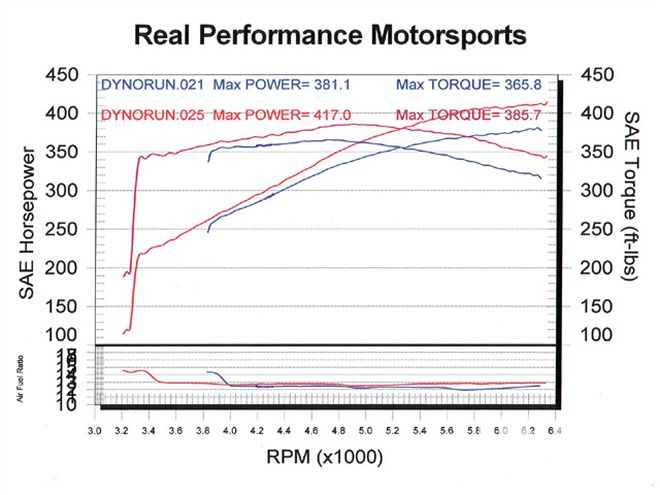
Drag Testing
Baseline drag testing was conducted at the Texas Motorplex in Ennis, Texas, which is a quarter-mile racing facility with a track elevation of 538 feet above sea level. Drag testing after installation was conducted at the quarter-mile facilities of San Antonio Raceway (SAR) during the Pontiac Southern Nationals. The track elevation of SAR is 646 feet above sea level.
The T/A improved upon its previous best of a 12.78 at 109.59 mph with a 12.67 at 111.75, but the numbers are somewhat misleading. The conditions for drag racing were terrible. Harold Baker told us, "With the high temperature and humidity levels, the bracket racers that I routinely race with were running 0.3 to 0.4 seconds slower than they did the day that I achieved the previous best time."
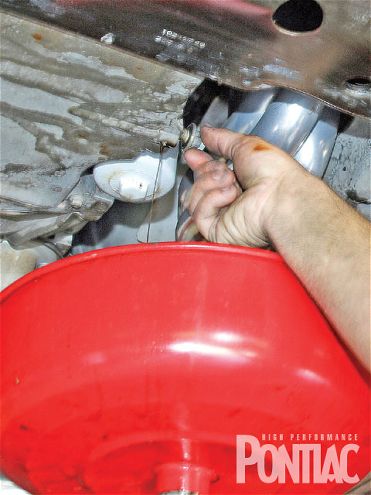
Due to the vastly different conditions between the baseline and PRC head drag testing, the elapsed time comparison would only be fair if the numbers were converted, so NHRA conversion factors were applied in order to compensate for differences in temperature, humidity, and barometric pressure.
After pulling down the weather data, calculating density altitude, and computing the adjusted e.t.'s and mph, it was clear that when the 12.67 became a 12.20 at 115.96 mph, the 0.39 second difference attributable to correction factors correlated perfectly with what the other racers were experiencing. On a good day in optimal conditions, the T/A just might knock down a 12-teen.
Since the PRC head testing was conducted as part of the bracket race at the Pontiac Southern Nationals in San Antonio, the car got quite a workout. Harold waded through a deep-field of entrants and narrowly missed a class win by a 0.0054-second breakout. Even heat-soaked, the difference between the best and worst pass at the track was less than 0.06 second. Fast and consistent-a bracket racer's dream come true!
At The TrackWeatherBaseline TestingTemperature66.6 degHumidity69%Barometric Pressure29.96 hgDensity Altitude1,313 ft WeatherTexas Speed Heads TestingTemperature{{{90}}}.1 degHumidity45%Barometric Pressure29.81 hgDensity Altitude3,169 ft Configuration, Best Run60 ft330 ft1/8 ET/MPH1/4 ET/MPHBaseline2.045.518.31/88.6512.79/109.59 Texas Speed Heads2.005.58.29/89.4812.67/111.75Improvement0.040.010.02/0.830.12/2.16Converted, Best Run1/4 ET1/4 MPHBaseline12.61111.14Texas Speed Heads12.20115.96Improvement0.394.82Configuration, Average60 ft330 ft1/8 ET/MPH1/4 ET/MPHBaseline2.075.558.36/88.42 12.84/109.40 Texas Speed Heads2.035.528.31/89.43 12.70/111.61 Improvement0.040.030.05/1.010.14/2.21Converted, Average1/4 ET1/4 MPH+ Baseline12.66111.04+ Texas Speed Heads12.28115.37Improvement0.384.33